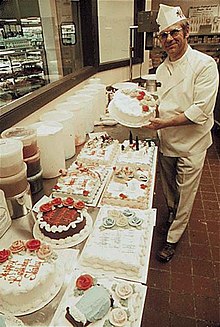Food manufacturing industry
The lebensmittelherstellende business manufactures foods and beverages in the non-industrial sector, so as part of the nutrition and food production sector .
It is part of the food industry . It mainly includes butchers, bakeries and confectioners. They are in competition with one another and with the food retail trade , but with much less importance of regional or even national bundling of demand. Local strategies prevail in both procurement and sales. The food trade continues to include a number of special industries, such as millers, brewers, maltsters and wine cooperatives. The official statistics of the German Federal Statistical Office now only include butchers , bakers and confectioners .
development
The importance of the food trade is steadily declining. Especially in the area of butcher shops, the market share is falling in favor of the supermarkets and, in particular, in favor of their self-service meat share. In the field of bakeries there is a predominant trend towards large industrial bakeries with affiliated sales branches, which have displaced many artisanal bakeries and will continue to displace them.
Recently, self-service bakery stores have been gaining traction, adding to this trend. In return, companies in the food industry try to position themselves on the one hand in the area of marketing regional products, on the other hand they strive to convey outstanding quality, e.g. B. by marketing products from quality programs. A combination of both approaches is often found. Another attempt to assert itself is made through additional service offerings. An example of this are snack areas in bakeries and butchers.
Market data
Throughout Germany, around 480,000 people (including part-time workers) work in the food trade in around 40,000 companies. Around 30,000 apprentices are completing vocational training in the food trade. The industry turnover is around 29 billion euros. Sources: Destatis, Central Association of German Crafts.
The delimitation between the food industry and the food trade is blurred. It is less common to differentiate between craft and industrial companies based on the manufacturing process than the number of employees. In the food industry , the official German statistics cover companies in the manufacturing sector with a size of 20 or more employees. The resulting number of companies is usually equated with the number of industrial companies. In the craft, membership is usually based on membership in guilds, chambers, etc. and not according to the size of the company. In the system of craft organizations, there can therefore also be larger craft businesses.
